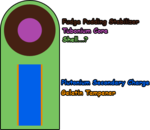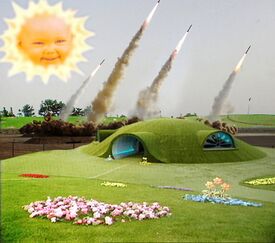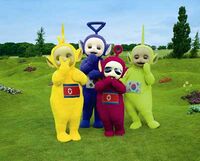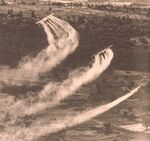The Great Teletubby War
The Great Teletubby War was a series of battles that began in 1997, ended in 2001, and then suffered endless repeats with TV syndication, mostly watched by Spawn and people in sociology classes. This conflict was the result of a disagreement between The Tubby Union[1] and The People's Democratic Teletubby Republic.[2] The high number of casualties, especially compared to the low number of Teletubbies ever actually seen on television, made it the most violent war in Teletubby history.
Origin of the conflict
Once upon a time, Teletubbyland was a happy, shiny, and sunny place of babbling, overweight fake fur balls bouncing around amongst the evergreen and cooing at one another in childish babble.
Then in 1895, the Japanese invaded and tried to turn everyone there into sad Anime cartoons. During this cruel time, the Teletubby Resistance was led by Kim-Kill Po, Lil Kim-Kong Laa-Laa, Park Chu Tinky Winky, and Samsung Itsy Bitsy Polka-Dot Dipsy. In a violent upheaval in which a lot of people got sick on jelly, the Japanese retreated and left Teletubbyland.
At first, all was happy once again. Then petty jealousies broke out between Po and Laa-Laa on one side, and Tinky Winky and Dipsy on the other. They kept to separate sides of the cheerfully verdant, rolling green hills, but then a very, very, very, very violent struggle broke out, replete with the flying of fuzzy-wuzzy fists and kicks to undefended Teletubby groins.
Po and Laa-Laa emerged as victors and announced—after long telephone exchanges with the Soviet premier—they would now "go Stalinist" and shoot pea soup at their rivals. Tinky Winky and Dipsy ran crying to the United Nations and asked General Douglas MacArthur to intervene on their behalf. The Chinese joined the fight, declaring Tinky Winky to be a bad moral influence and Dipsy a decadent, Westernised alcoholic.
Two-nation Teletubbies
Teletubbyland split into two separate nations, the People's Democratic Teletubby Republic and Tubby Union. Both Air Marshal Laa-Laa and General Po spoke of advancing the international proletarian struggle (less so of their own accretion of unprecedented political power). By comparison, Generals Tinky Winky and Dipsy disagreed; the television program and the related merchandising deals made them devout believers in capitalism, from their heads down to their pinky rings.
After the split, both sides formed executive offices that had never before been needed, with salaries in excess of any that had been paid prior. The Tubby Union had a president and vice-president, and the People's Democratic Teletubby Republic had Chairmen and the People's Grand High Tubby (acting president, social spokesperson and official state party animal).
The secession caused the cession of speculation as to which, if any, of the Teletubby leadership was gay. In fact, the People's Democratic Teletubby Republic promptly passed a law against any discussion of the sexuality of leadership, proving once and for all that all such rumors were completely unfounded.
Six-party negotiations
When the dispute escalated to the point of war, the United States lined up on the side of the capitalist Tubby Union, whereas the socialist nations sided with the People's Democratic Teletubby Republic. The U.S. requested peace negotiations with the People's Democratic Teletubby Republic, but the latter wanted six-party negotiations, even though only two nations were party to the dispute (three, if you count the U.S. as a global ATM with a stuck refund knob). Air Marshal Laa-Laa was unabashed: "We find it easier to play the U.S. like a fiddle when there are three extra parties watching the negotiations," she said. The People's Democratic Teletubby Republic chose the following:
- North Korea, experienced at the scheme and always a reliable witness to the truth.
- The BBC, with an obvious interest both in peace and expanded Teletubbies syndication, and whose news division is actively in the business of shaming the U.S. into disgorging large amounts of cash into diplomatic rat-holes.
- The People's Republic of China, which manufactures all the consumer goods and most of the food consumed in the U.S. and could exert leverage on the U.S. to do its part ($$$) to stop the hostilities.
The result of the six-party negotiations was that the U.S. shipped enough food to the People's Democratic Teletubby Republic to feed 40% of its population--an amount which, coincidentally, was sufficient to feed 100% of its military, which took delivery of, and administered, the food aid. In exchange, the People's Democratic Teletubby Republic promised to keep telling the U.S. that it was not engaged in a secret armaments campaign, at least until it was undeniable because of the firing of test missiles.
Chemical and Biological Weaponry
Teletubbian Anthrax
Both sides developed synthetic variants of normal Anthrax, designed to survive for years at a time and infect a variety of the foodstuffs eaten by the stuffed toys that constitute Teletubbyland.
The Tubby Union developed an antigen to Teletubbian Anthrax. The People's Democratic Teletubby Republic protested that such an effective defensive weapon would embolden the Tubby Union toward economic and cultural aggression, and was thus an offensive weapon. They demanded that the Tubby Union pledge never to use the antigen in a first strike; that is, never to be the first to immunize its people after an attack with a biological weapon.
Agent Wahda
With equal parts left-over methyl isocyanate sold to the Union by unscrupulous American chemical corporations and pink dye, Agent Wahda was made and used exclusively by the Tubby Union as a chemical weapon and dispensed through dusters, helicopters, and noo-noos. Agent Wahda proved highly effective, far more than the other chemical weapons, killing and staining hundreds of Teletubbies.
Tubonium Bomb

Near the end of the war, the Tubby Union feared that the People's Democratic Teletubby Republic was developing a mega-weapon. Their own project led to the modern Tubonium Bomb. The element Tubonium (Tb, Atomic Number 321), much like the Teletubbies themselves, is inherently unstable and prone to giggling fits when anyone mentions poopoo. However, the Tubby Union added a lot of paste and sticky fudge pudding and made it far more effective.
The Tubonium Bomb proved to be a major success, twenty-six times as devastating as the H-Bomb, with the capacity to kill all infant toys on the continent of North America, and to penetrate bunkers whether hardened with Lego or Duplo blocks. The bomb is also capable of emitting an EMP so massive that tummy-TV based communications are disrupted for more than two hours over the blast radius. This fact proved vital in the bomb's success during the war.
Deployment and surrender
On June 4, the first Tubonium bomb went off in the metropolis of Qay Qay. Millions of innocent Teletubbies watched in horror as their little fat bellies expanded and then exploded into a deluge of colorful fur and saturated fats. To the surprise of the Union, the People's Democratic Teletubby Republic refused to surrender, its government instead entering a prolonged period of internal dithering. Approximately two months later (the man with the exact numbers was sacked long before any authoritate documents went to print), a second bomb went off. The People's Democratic Teletubby Republic officially surrendered, marking the end of the Great War.
Following a tense occupation and further deliberation on the part of external powers, the People's Democratic Teletubby Republic and the Tubby Union were united for the first time in centuries. The oligarchy was restored, and with it a new era of peace and prosperity. Namely, the United States provided reconstruction aid and reparations (though for what may have been the first time in remembered history, the United States hadn't actually done anything wrong during the conflict) and started two baseball leagues. The leaders swore never to wage war again.
At least, not until the loot runs out.
References
- ↑ Consisting of Generals Tinky Winky and Dipsy
- ↑ Consisting of Laa-Laa and Po



